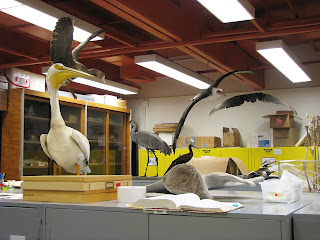In the interest of saving time, I am combining what could potentially be three different posts into one...
1. Taxidermy
2. Storm remnants
3. Discovery
TAXIDERMY
The Museum of Natural History Collection at UC Santa Cruz houses over 49,000 specimens of plants, fungi, insects, fishes, amphibians, reptiles, birds and mammals. For those of you who live in the Bay Area are probably familiar with San Francisco's Paxton Gate and Albany's The Bone Room. Imagine the fabulousness of these two stores times four. Most of these specimens are available for loan to the school's faculty, students and staff. But because the Science Illustration Program used to be a part of UC Santa Cruz, the museum has decided to be nice enough to continue borrowing privileges to us. So awesome! I just borrowed a Hoary Bat and three Hawk Moths.



How beautiful are the feathers on this pelican??? Wow!
STORM REMNANTS
Last weekend, I went to Santa Cruz for a day to give surfing a go. I'm not very good at it yet, but I'm working on it. A few days before, the area experienced a pretty rough storm and the beach was just covered with washed up kelp and seaweed along with other fun finds. One of them was a dead seal. I know. It's gross. This one's skull was super exposed. So much so that I admittedly wanted to yank the skull out and keep it. I thought better of it and just took pictures of it instead.
DISCOVERY
Do you remember my drawing from awhile ago? The one of the unknown flowering tree? I know what it is! It is called a Hakea Epiglottis and is part of the Protea family. Now I'm going to pat myself on the back a little bit because when I first saw the specimen, I remarked how much the bloom bore a resemblance to a tiny little protea. Oh you can imagine how much I beamed with the recent discovery. How did I go about finding out what my mystery tree is, you ask? Well, let me tell you. It was very profound and very difficult. I asked a friend of a friend who happened to be a landscaper if he knew what it was. Fortunately for me, he did! I first described it to him and he said that he thought it was a hakea. Then I showed him my drawing and he said, "Yup. That's a hakea." This particular species of hakea is native to Tasmania.














No comments:
Post a Comment